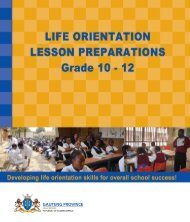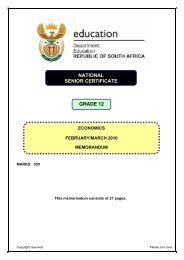Life Science Grade 11
Life Science Grade 11
Life Science Grade 11
Create successful ePaper yourself
Turn your PDF publications into a flip-book with our unique Google optimized e-Paper software.
<strong>Grade</strong> <strong>11</strong> <strong>Life</strong> <strong>Science</strong>s Lesson PlansGRADE <strong>11</strong> SUBJECT <strong>Life</strong> <strong>Science</strong>s WEEK Week 3 TOPIC Vaccines and antibiotics LESSON 3LESSON SUMMARY FOR: DATE STARTED:LESSON OBJECTIVESDATE COMPLETED:Content:• A vaccine is a suspension of weakened or dead pathogens that will stimulate antibody production• Vaccinations consist of giving vaccines to help make a person immune to a specific disease• Lymphocytes respond to the vaccine by making antibodies which remain in the body and will react if a live pathogen enters the body• Antibiotics are substances that destroy bacteria without affecting living cells• They are secreted by fungi such as Penicillium and Streptomyces• Antibiotics may adversely affect the cell wall, membrane or prevent protein synthesis in bacteriaThe learner must be able to:• Describe what a vaccine is and how it helps the immune system• Describe how vaccinations help strengthen the immune system• Discuss the process that occurs once the body has received a vaccination• Describe what an antibiotic is and how it helps the immune system• Describe what an antibiotic is and how it helps the immune system• Participate in a class discussion on the advantages and disadvantages of vaccinationsTEACHER ACTIVITIES LEARNER ACTIVITIES TIMING RESOURCES NEEDED1.1 Introduction• Pre –knowledge: white blood cells produce antibodies in the body when a pathogenenters the blood• Remind learners of how the active response of the immune system acts on pathogens• Remind learners that antibiotics are effective against bacteria but not viruses10 min2.2 Main Body (Lesson presentation)• The following must be highlighted by use of blackboard/transparencies and classdiscussion:• A vaccine is a suspension of dead or weakened pathogens that will stimulate theproduction of antibodies in the blood.• These antibodies will strengthen the immunity of the body and help protect againstspecific diseases• Vaccines are made from live pathogens grown in labs• Through various processes they will then be killed or continually grown until they aremuch weaker than the original pathogen• These organisms are then used to make vaccines• Vaccines may be administered by injection, by scratching the skin or by ingesting it• When a person receives a vaccination the lymphocytes produce antibodies for thepathogen contained in the vaccine.• The antibodies then remain in the blood for some time and if the person is infected bythe live pathogen, the antibodies will destroy them right away.20 min• Internet reference: (The makingof vaccines)• http://www.madehow.com/Volume-2/Vaccine.html• http://health.howstuffworks.com/wellness/preventiveare/vaccine4.htm• How vaccines work and history• http://www.accessexcellence.org/AE/AEC/CC/vaccines_how_why.php• Internet reference: (Howantibiotics work)• http://science.howstuffworks.coTerm 1 Page 21© Gauteng Department of Education (CAPS version)







